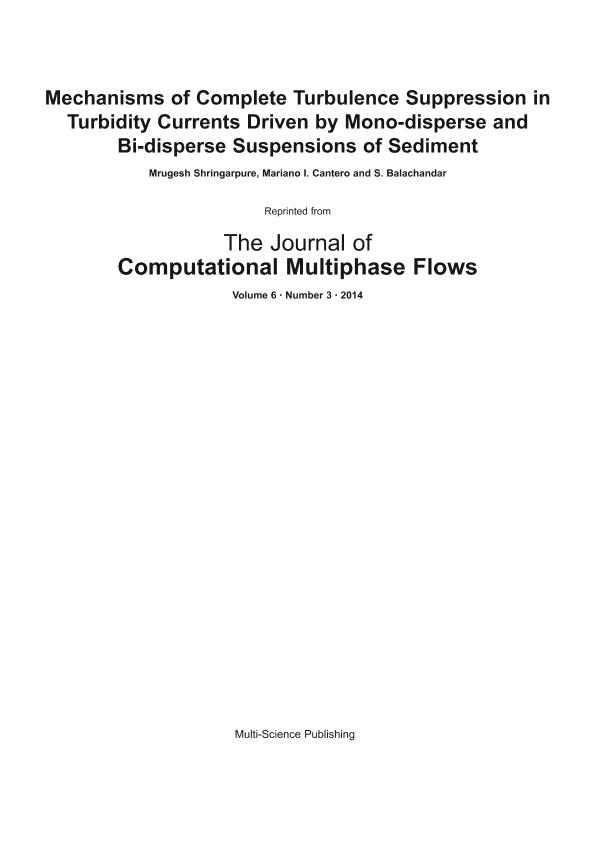Artículo
Mechanisms of Complete Turbulence Suppression in Turbidity Currents Driven by Mono-Disperse and Bi-Disperse Suspensions of Sediment
Fecha de publicación:
09/2014
Editorial:
Sage Publications
Revista:
Journal of Computational Multiphase Flows
ISSN:
1757-482X
e-ISSN:
1757-4838
Idioma:
Inglés
Tipo de recurso:
Artículo publicado
Clasificación temática:
Resumen
Turbidity currents are submarine flows where the sediment fluid mixture (heavy current) drives along the sloping ocean floor displacing the surrounding clear fluid (light ambient). Under the influence of gravity, the suspended sediments drive the current and at the same time settle down on the ocean bed. The interplay of turbulent mixing and settling sediments leads to stable stratification of sediments in the turbidity current. In previous studies (Cantero et al. 2009b; Cantero et al., 2009a; Cantero et al., 2012a; Talling et al., 2007) it was observed that strong settling tendency (large sediment sizes) could cause complete turbulence suppression. In this study, we will analyse this process of complete turbulence suppression by means of direct numerical simulations (DNS) of turbidity currents. In wall bounded unstratified flows, it has been long established that turbulence is sustained by the process of auto-generation of near-wall hairpin like and quasi-streamwise turbulent vortical structures. It was also identified that auto-generation is possible only when the strength of the turbulent structures is greater than a threshold value (Zhou et. al., 1996). Through quadrant analysis of Reynolds stress events and visualization of turbulent vortical structures, we observe that stratification by sediments lead to damping and spatial re-distribution of turbulent vortical structures in the flow. We propose that complete turbulence suppression is brought about by a total shutdown in the auto-generation process of the existing turbulent structures in the flow. We also identify three parameters – Reynolds number (Reτ), Richardson number (Riτ) and sediment settling velocity (V˜z) that quantify the process of turbulence suppression. A criterion for complete turbulence suppression is also proposed which can be defined as a critical value for RiτV˜z. This critical value is a function of Ret and based on simulations, experiments and field observations it appears to have a logarithmic dependence on Reτ (Cantero et al. 2012). DNS of turbidity currents driven by bi-disperse suspension of sediments is also carried out and compared with the results of mono-disperse suspensions.
Palabras clave:
Turbidity Currents
Archivos asociados
Licencia
Identificadores
Colecciones
Articulos(CCT - PATAGONIA NORTE)
Articulos de CTRO.CIENTIFICO TECNOL.CONICET - PATAGONIA NORTE
Articulos de CTRO.CIENTIFICO TECNOL.CONICET - PATAGONIA NORTE
Citación
Selvakumar, Balachandar; Shringarpure, Mrugesh S.; Cantero, Mariano Ignacio; Mechanisms of Complete Turbulence Suppression in Turbidity Currents Driven by Mono-Disperse and Bi-Disperse Suspensions of Sediment; Sage Publications; Journal of Computational Multiphase Flows; 6; 3; 9-2014; 221-245
Compartir
Altmétricas




